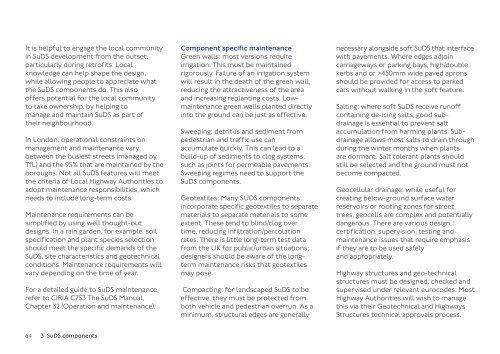SuDS in London - a guide
sustainable-urban-drainage-november-2016
sustainable-urban-drainage-november-2016
Create successful ePaper yourself
Turn your PDF publications into a flip-book with our unique Google optimized e-Paper software.
It is helpful to engage the local community<br />
<strong>in</strong> <strong>SuDS</strong> development from the outset,<br />
particularly dur<strong>in</strong>g retrofits. Local<br />
knowledge can help shape the design,<br />
while allow<strong>in</strong>g people to appreciate what<br />
the <strong>SuDS</strong> components do. This also<br />
offers potential for the local community<br />
to take ownership, by help<strong>in</strong>g to<br />
manage and ma<strong>in</strong>ta<strong>in</strong> <strong>SuDS</strong> as part of<br />
their neighbourhood.<br />
In <strong>London</strong>, operational constra<strong>in</strong>ts on<br />
management and ma<strong>in</strong>tenance vary<br />
between the busiest streets (managed by<br />
TfL) and the 95% that are ma<strong>in</strong>ta<strong>in</strong>ed by the<br />
boroughs. Not all <strong>SuDS</strong> features will meet<br />
the criteria of Local Highway Authorities to<br />
adopt ma<strong>in</strong>tenance responsibilities, which<br />
needs to <strong>in</strong>clude long-term costs.<br />
Ma<strong>in</strong>tenance requirements can be<br />
simplified by us<strong>in</strong>g well thought-out<br />
designs. In a ra<strong>in</strong> garden, for example, soil<br />
specification and plant species selection<br />
should meet the specific demands of the<br />
<strong>SuDS</strong>, site characteristics and geotechnical<br />
conditions. Ma<strong>in</strong>tenance requirements will<br />
vary depend<strong>in</strong>g on the time of year.<br />
For a detailed <strong>guide</strong> to <strong>SuDS</strong> ma<strong>in</strong>tenance,<br />
refer to CIRIA C753 The <strong>SuDS</strong> Manual,<br />
Chapter 32 (Operation and ma<strong>in</strong>tenance).<br />
Component specific ma<strong>in</strong>tenance<br />
Green walls: most versions require<br />
irrigation. This must be ma<strong>in</strong>ta<strong>in</strong>ed<br />
rigorously. Failure of an irrigation system<br />
will result <strong>in</strong> the death of the green wall,<br />
reduc<strong>in</strong>g the attractiveness of the area<br />
and <strong>in</strong>creas<strong>in</strong>g replant<strong>in</strong>g costs. Lowma<strong>in</strong>tenance<br />
green walls planted directly<br />
<strong>in</strong>to the ground can be just as effective.<br />
Sweep<strong>in</strong>g: detritus and sediment from<br />
pedestrian and traffic use can<br />
accumulate quickly. This can lead to a<br />
build-up of sediments to clog systems,<br />
such as jo<strong>in</strong>ts for permeable pavements.<br />
Sweep<strong>in</strong>g regimes need to support the<br />
<strong>SuDS</strong> components.<br />
Geotextiles: Many SUDS components<br />
<strong>in</strong>corporate specific geotextiles to separate<br />
materials to separate materials to some<br />
extent. These tend to bl<strong>in</strong>d/clog over<br />
time, reduc<strong>in</strong>g <strong>in</strong>filtration/percolation<br />
rates. There is little long-term test data<br />
from the UK for public/urban situations;<br />
designers should be aware of the longterm<br />
ma<strong>in</strong>tenance risks that geotextiles<br />
may pose.<br />
Compact<strong>in</strong>g: for landscaped <strong>SuDS</strong> to be<br />
effective, they must be protected from<br />
both vehicle and pedestrian overrun. As a<br />
m<strong>in</strong>imum, structural edges are generally<br />
necessary alongside soft <strong>SuDS</strong> that <strong>in</strong>terface<br />
with pavements. Where edges adjo<strong>in</strong><br />
carriageways or park<strong>in</strong>g bays, high/double<br />
kerbs and or >450mm wide paved aprons<br />
should be provided for access to parked<br />
cars without walk<strong>in</strong>g <strong>in</strong> the soft feature.<br />
Salt<strong>in</strong>g: where soft <strong>SuDS</strong> receive runoff<br />
conta<strong>in</strong><strong>in</strong>g de-ic<strong>in</strong>g salts, good subdra<strong>in</strong>age<br />
is essential to prevent salt<br />
accumulation from harm<strong>in</strong>g plants. Subdra<strong>in</strong>age<br />
allows most salts to dra<strong>in</strong> through<br />
dur<strong>in</strong>g the w<strong>in</strong>ter months when plants<br />
are dormant. Salt tolerant plants should<br />
still be selected and the ground must not<br />
become compacted.<br />
Geocellular dra<strong>in</strong>age: while useful for<br />
creat<strong>in</strong>g below-ground surface water<br />
reservoirs or root<strong>in</strong>g zones for street<br />
trees, geocells are complex and potentially<br />
dangerous. There are various design,<br />
certification, supervision, test<strong>in</strong>g and<br />
ma<strong>in</strong>tenance issues that require emphasis<br />
if they are to be used safely<br />
and appropriately.<br />
Highway structures and geo-technical<br />
structures must be designed, checked and<br />
supervised under relevant eurocodes. Most<br />
Highway Authorities will wish to manage<br />
this via their Geotechnical and Highways<br />
Structures technical approvals process.<br />
64 3 <strong>SuDS</strong> components


